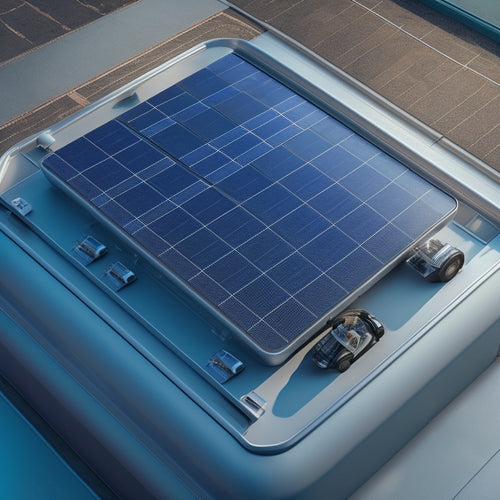
Diagnosing Power Issues in Your Home System
Share
You're likely no stranger to the frustrations of power issues in your home system, where faulty electrical components, voltage fluctuations, and corroded terminals can cause everything from flickering lights to electrical fires. To diagnose the issue, start by identifying the symptoms: is your system shutting off or operating at low voltage? Are your lights flickering or appliances malfunctioning? Check for inverter failure, loose connections, panel damage, or electrical ground faults. Incorrect meter readings or grid connection issues could also be to blame. Uncover the root cause of your power issues and take the first step towards a safer, more reliable home electrical system - there's more to explore to get your system running smoothly.
Key Takeaways
• Regularly inspect your home electrical system to identify and address potential issues before they cause power problems.
• Check for signs of wear, corrosion, or damage on electrical components, such as outlets, switches, and circuit breakers.
• Ensure your electrical panel is functioning properly, with no signs of overheating, rust, or corrosion that can lead to power issues.
• Monitor your system's accuracy by regularly checking and adjusting sensors and meters to prevent data drift and calibration errors.
• Address power issues promptly, as delaying repairs can lead to costly mistakes, misdiagnosis, and even fires or system failure.
System Shutoff or Low Voltage
If your system shuts down or experiences low voltage, it's likely because the electrical load exceeds the capacity of your main service or a faulty electrical component is causing a voltage drop.
Don't panic, it's not the end of the world! It's just your system's way of saying, 'Hey, I need a break!' But seriously, voltage fluctuations can be a real pain. Power surges, for instance, can damage your appliances or even cause a fire.
So, what's the culprit behind this electrical chaos? It could be that new power-hungry gadget you just plugged in, or maybe it's a faulty wire or electrical panel. Whatever the reason, it's essential to identify the source of the issue before it causes more harm.
Take a closer look at your electrical setup and see if you can spot the problem. Check for overheated wires, tripped circuit breakers, or blown fuses. If you're still stumped, it might be time to call in a pro to help you troubleshoot the issue and get your system back up and running smoothly.
Inverter Failure or Malfunction
Your inverter, an essential component in your home system, can fail or malfunction due to internal faults, overheating, or electrical surges, leaving you without power. You're left wondering what's going on and how to get your system up and running again.
Inverter failure or malfunction can be a real power-sucking problem (pun intended!). One common culprit is inverter overload, which happens when your inverter is pushed beyond its capacity. This can cause it to shut down or malfunction, leaving you in the dark.
Another issue is battery drain, which can cause your inverter to malfunction or fail altogether. If you notice your batteries are draining faster than usual, it may be a sign of an underlying issue with your inverter. To diagnose the problem, check your inverter's temperature, voltage, and current output.
If you're not sure what you're doing, it's always best to consult a professional to avoid making things worse. By identifying the root cause of the issue, you can get your system back up and running in no time.
Loose or Faulty Connections Found
Inspect your system's wiring and connections, as loose or faulty connections can cause power issues, from flickering lights to complete system failure. You'd be surprised how often a simple loose screw or corroded terminal can wreak havoc on your entire system.
To identify the culprits, perform a thorough connection testing. Check for signs of wear, corrosion, or damage on wire insulation. Use a multimeter to test for voltage drops or resistance across connections.
Here's a quick reference guide to get you started:
| Connection Issue | Symptoms |
|---|---|
| Loose Connections | Flickering lights, intermittent power outages |
| Corroded Terminals | Sparking, burning smells, or complete system failure |
| Damaged Wire Insulation | Electrical shocks, fire hazards, or appliance damage |
| Overheated Connections | Burning smells, tripped breakers, or system shutdowns |
Panel Damage or Debris Obstruction
As you inspect your home's electrical panel, you're looking for signs of damage or obstruction that could be causing power issues.
Check for debris accumulation, which can lead to overheating or even fires, and inspect for corrosion signs that may indicate water damage or exposure.
Debris Accumulation Risks
Debris accumulation on your roof or around your home's exterior can lead to panel damage or debris obstruction, causing power issues and system downtime. As a homeowner, it's important to be aware of the risks associated with debris accumulation. Dust buildup, leaf accumulation, and other debris can clog your system, reducing its efficiency and potentially causing damage.
Here's a breakdown of the risks associated with debris accumulation:
| Debris Type | Risk Level | Potential Consequences |
|---|---|---|
| Leaf accumulation | High | Panel damage, system overheating |
| Dust buildup | Medium | Reduced system efficiency, overheating |
| Bird nests | Low | Minor system obstruction, easy cleanup |
| Tree branches | High | Severe system damage, power outages |
| Animal waste | Medium | System contamination, health risks |
Don't let debris accumulation catch you off guard. Regularly inspect your roof and exterior for signs of debris buildup, and take prompt action to clear any obstructions. By staying proactive, you can prevent power issues and guarantee your system runs smoothly. Remember, a clean system is a happy system!
Panel Corrosion Signs
Your solar panels are susceptible to corrosion from environmental factors, and you should be on the lookout for signs of panel damage or debris obstruction that can reduce their efficiency. Don't let rust formation and moisture buildup sneak up on you – it's important to inspect your panels regularly.
Check for signs of corrosion, such as rust stains, flaking paint, or corrosion-induced delamination. If you notice any of these signs, it's vital to address them promptly to prevent further damage.
Moisture buildup is another culprit that can lead to corrosion. Look out for water spots, mineral deposits, or condensation on the panels. If you live in a coastal area, saltwater corrosion can be a significant concern.
To prevent corrosion, make sure your panels are installed at an angle that allows water to run off, and clean them regularly to remove dirt and debris.
Electrical Ground Fault Issues
As you investigate power issues in your home system, you'll want to examine electrical ground fault issues, which can be caused by faulty wiring, worn-out connections, or water damage.
You'll need to identify signs of ground faults, such as flickering lights, warm outlets, or burning smells, to prevent electrical shocks or even fires.
Ground Fault Causes
Ground faults often occur when an unintended path to ground is created, allowing electrical current to flow to the earth through a person's body or an object. This can happen when you least expect it, and it's not a pleasant experience, trust us.
So, what causes these pesky ground faults? Well, you're about to find out. Grounding errors are a common culprit. When the grounding system in your home isn't installed or maintained correctly, it can lead to a ground fault. Faulty installations, like a sloppy wiring job, can also create a path to ground where there shouldn't be one. Imagine a wire touching a metal pipe, and you get the idea. These errors can be critical, so it's important to identify and fix them ASAP.
As you inspect your home's electrical system, keep an eye out for these potential ground fault causes. Make sure all electrical components, like outlets and switches, are properly grounded. And if you're not sure what you're doing, don't hesitate to call in a pro – it's better to be safe than shocked!
Faulty Wiring Signs
When inspecting your home's electrical system, you'll want to look out for signs of faulty wiring, such as flickering lights, warm outlets, or burning smells, which can indicate electrical ground fault issues. These warning signs can be subtle, but they're essential to catch before things get out of hand.
Take note of the wiring age, as older wiring is more prone to faults. Check the wire color, too - if it's discolored or corroded, it's a red flag. That electrical odor you can't quite place? It might be a sign of overheating wires.
And don't even get us started on melted plastics - that's a serious fire hazard waiting to happen. If you notice any of these signs, it's time to call in a pro to assess the situation. Don't try to DIY your way out of this one; faulty wiring can be deadly.
Prevention Methods Needed
To prevent electrical ground fault issues, you'll need to take proactive steps to make sure your home's electrical system is safe and reliable. Regular maintenance is key to identifying potential problems before they become major issues. By keeping your electrical system in top shape, you'll not only guarantee your safety but also increase energy efficiency.
Here are some prevention methods you can implement:
| Method | Description | Frequency |
|---|---|---|
| Visual Inspection | Check for signs of wear, corrosion, or damage on outlets, switches, and cords. | Monthly |
| Circuit Breaker Maintenance | Check and reset tripped circuit breakers to ensure they're functioning correctly. | Quarterly |
| Electrical Panel Inspection | Inspect the electrical panel for signs of overheating, rust, or corrosion. | Semiannually |
| Outlet and Switch Replacement | Replace outdated or damaged outlets and switches with new ones. | As needed |
| Professional Inspection | Hire a licensed electrician to inspect your electrical system for potential issues. | Annually |
Monitoring System Inaccuracy
Inaccurate monitoring system readings can lead to misdiagnosis of power issues, causing you to waste time and resources on unnecessary repairs. You might think you're tackling the problem, but you're actually just throwing money at a non-existent solution. It's like trying to fix a leaky faucet by replacing the entire sink – it's a costly mistake.
One common culprit behind monitoring system inaccuracy is data drift. This occurs when your sensors or meters gradually deviate from their initial calibration, giving you skewed readings. It's like having a wonky thermostat that thinks it's winter in July – you'll be sweating bullets while your AC cranks away.
Calibration errors are another sneaky saboteur of accurate monitoring. If your equipment isn't properly calibrated, you might as well be flipping a coin to diagnose your power issues. It's a shot in the dark, and you'll likely end up chasing the wrong problem.
To prevent these pitfalls, regularly check and adjust your monitoring system to make sure it's providing you with reliable data. Your wallet (and your sanity) will thank you.
Grid Connection or Meter Issues
Identifying and addressing these issues promptly is crucial to avoid unnecessary headaches. One common culprit is meter calibration. If your meter isn't accurately calibrated, it can lead to incorrect readings, which can, in turn, cause you to misdiagnose the problem. Make sure that your meter is calibrated regularly to prevent this issue.
Other grid connection or meter issues to watch out for include:
-
Grid synchronization: Confirm that your system is synchronized with the grid frequency to prevent power quality issues.
-
Meter tampering or damage: Check for any signs of tampering or physical damage to the meter, which can affect its accuracy.
-
Incorrect meter installation: Validate that the meter is installed correctly to prevent any issues with power quality or billing.
Frequently Asked Questions
Can a Power Issue in One Room Affect the Entire Home System?
Yeah, a power issue in one room can definitely affect your entire home system, causing cascading failures that'll leave you in the dark - unless you've got electrical isolation in place to contain the problem!
How Often Should I Inspect My Home's Electrical System?
You should inspect your home's electrical system every 10-15 years, or when you notice issues, to conduct electrical maintenance and safety checks. Stay on top of regular updates to avoid electrical shocks and fires!
Are Power Surges Covered Under Homeowners' Insurance Policies?
You're wondering if power surges are covered under your homeowners' insurance policy. Typically, policies don't cover damage from power surges due to Insurance Exclusions and Policy Limitations, but it's essential to review your policy to confirm the specifics.
Can I Diagnose Power Issues on My Own Without an Electrician?
You can attempt DIY troubleshooting, but remember, safety precautions are key! Start by checking your circuit breaker or fuse box, then inspect outlets and cords for damage, but don't hesitate to call an electrician if you're unsure.
Will a Whole-Home Surge Protector Eliminate All Power Issues?
You're wondering if a whole-home surge protector is a magic fix-all for power issues? Not quite - while it shields against voltage spikes, its surge capacity has limitations, and it won't eliminate all issues, sorry!
Related Posts
-

Top Solar Panels for Car Battery Maintenance
When selecting top solar panels for car battery maintenance, consider high-efficiency models with high wattage output...
-

What You Need to Know About Permits and Inspections
You need to navigate the complex landscape of permits and inspections to guarantee your project complies with local z...
-

Solar Power Units Perfect for Homes
You're considering installing a solar power unit in your home, a decision that can notably reduce your reliance on tr...


